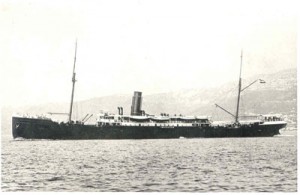A short(ish) journey by car or boat to the north west of Paleochora is the island of Elaphonissi, famed these days for the quality of its beaches and its wildlife sanctuary. However, exactly 105 years ago from the date and time that this post is being published, Elaphonissi was the scene of a major maritime disaster.
The steam ship S.S. Imperatrix was completed towards the end of 1888 and described as the pride of the Lloyds-Austrico (Austrian Lloyds) line. She was as a passenger/freight steamer built specifically to carry passengers through the Suez Canal to India and in particular to take part in the regular “Express” service to Bombay (Mumbai); a route described in 1904 as taking 18 days to reach Bombay from Trieste. While at just over 4000 tons gross weight she was small by modern standards, at the time she was laid down she was one of the largest ships in the Lloyds-Austrico fleet and ships of her size were regularly carrying up to 500 or more passengers on the immigrant routes between Europe and America. The Imperatrix herself normally had a passenger list of 113 and on the night of her wrecking, according to the account of the wreck carried in the Lloyds Weekly Shipping report dated 28th February 1907, she had on board 120 crew including cargo hands and 20 passengers including two children and four nuns.
On the night of 22th February 1907, commanded by Captain G. Ghezzo, the Imperatrix was travelling from Trieste to Bombay when, sailing down the western coast of Crete in a severe gale and already several kilometres off course because of a navigation error, she was driven onto the rocks off the north west extremity of Elaphonissi. Contemporary newspaper accounts describe how she was initially driven aground before being thrown onto the rocks by her stern.
The captain ordered the crew and passengers forward to try and stop her breaking her back but by then a large hole had been made in her side: she started to sink by the stern and it was clear that she was not going to be able to be refloated. During the confusion and against orders, some of the crew took to the lifeboats or jumped in the water and abandoned ship. This proved to be disastrous and the 40 or so who left the vessel at this time drowned. However, about 12 persons, led by the Imperatrix’s First Lieutenant, did get to the shore and raised the alarm. Those left on board were now stuck on the forward deck where they remained for the next day and a half without food or water.
Throughout the night of the wreck, local Cretan villagers made attempts to get a line those stranded on the ship while one unmanned villager set off by horseback in the snow to make what would be a 15 hour journey over the mountains to raise the alarm in Chania. On the morning of 24th February the storm had abated and with the stern of the ship now underwater and the vessel in danger of breaking up, the locals and the crew finally managed to construct a bridge of debris between the shore and the ship over which the remaining crew and passengers were evacuated.
The survivors were initially tended to by the local villagers, aided by the arrival of supplies and blankets from the nearby Panagia Chrisoskalitissa monastery. Upon the news of the wreck reaching Chania, the Imperial Russian Navy, which had warships on station as one of foreign powers party to the 1898 Cretan autonomy agreement, sent a torpedo boat, No 212, to assist; closely followed by the gunboat Chivinetz. The French Navy sent the torpedo cruiser Faucon and the Italian Navy sent the gunboat Curatone to the scene. These vessels, along with the Lloyds-Austrico steamer Castore, which the company immediately diverted to the scene on learning of the wreck, took on board the survivors and eventually brought them to Chania.
The vessel itself was a total loss, its bulk cargo of sugar not being salvageable, and all that remains of it today, at a depth of 17 metres and accessible only by small boat, is a few bulkheads and a scattering of glass beads. The crew of the Imperatrix who were lost in the wreck are buried in an unmarked grave on the island but their real monument was the stone lighthouse that was built shortly after the wreck in an attempt to prevent it’s like recurring; unfortunately this lighthouse was demolished by retreating German forces at the end of World War II.
Further details of the wreck of the Imperatrix can be found at:
www.imperatrix.co.uk



Recent Comments